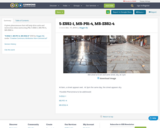
A given phenomenon that will help drive units and instruction when instructing PEs: 5-ESS2-1, MS-PS1-4, MS-ESS2-4
- Subject:
- Applied Science
- Environmental Science
- Physical Science
- Material Type:
- Teaching/Learning Strategy
- Date Added:
- 12/14/2018

A given phenomenon that will help drive units and instruction when instructing PEs: 5-ESS2-1, MS-PS1-4, MS-ESS2-4
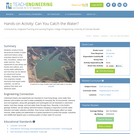
Students construct three-dimensional models of water catchment basins using everyday objects to form hills, mountains, valleys and water sources. They experiment to see where rain travels and collects, and survey water pathways to see how they can be altered by natural and human activities. Students discuss how engineers design structures that impact water collection, as well as systems that clean and distribute water.
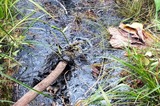
Meaningful STEM learning can happen at home as we use our imagination to solve real problems! This STEM project introduces students to the problem of oil spills around the world. The project culminates with students using their imagination to design a solution to the problem.
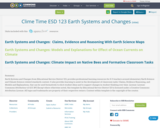
Earth Systems and Changes from Educational Service District 123, provides professional learning resources for K-5 teachers around elementary Earth Science and Climate Science related standards content.
It also provides learning to assist in the development of classroom tasks: Claims, Evidence Reasoning, and Models and Explanations, that can be used formatively to elicit student ideas and to support changes in student thinking over time.
License: License: Commons Attribution 4.0 (CC BY)
Except where otherwise noted, this template by Educational Service District 123 is licensed under a Creative Commons Attribution License. All logos and trademarks are property of their respective owners. Content within template is the copyright of the creator.
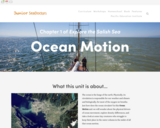
In this unit, students wonder about the physical drivers of ocean movement, explore density differences, and take a look at some tiny creatures who struggle to keep their place in the water column in the midst of all that ocean motion.
Each unit of the Explore the Salish Sea curriculum contains a detailed unit plan, a slideshow, student journal, and assessments. All elements are adaptable and can be tailored to your local community.
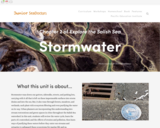
In Unit 2 of the Explore the Salish Sea curriculum, students will review the water cycle, learn the parts of a watershed, and the effects of erosion and pollution, then learn ways of purifying these waters before they enter our streams and estuaries to safeguard these ecosystems for marine life and us.
Each unit in this series contains a detailed unit plan, a slideshow, student journal, and assessments. All elements are adaptable and can be tailored to your local community.
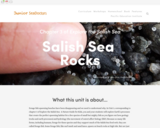
Salish Sea Rocks is Unit 3 of the Explore the Salish Sea Curriculum. Each unit contains a detailed unit plan, a slideshow, student journal, and assessments. All elements are adaptable and can be tailored to your local community.
In the unit, students will explore Earth’s processes that create the perfect spawning habitat for a few species of small but mighty fish.
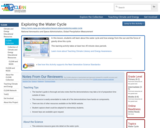
In this lesson, students will learn about the water cycle and how energy from the sun and the force of gravity drive this cycle.
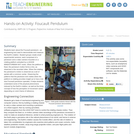
Students learn about the Foucault pendulum an engineering tool used to demonstrate and measure the Earth's rotation. Student groups create small experimental versions, each comprised of a pendulum and a video camera mounted on a rotating platform actuated by a LEGO MINDSTORMS(TM) NXT motor. When the platform is fixed, the pendulum motion forms a line, as observed in the recorded video. When the rotating, the pendulum's motion is observed as a set of spirals with a common center. Observing the patterns that the pendulum bob makes when the platform is rotating provides insight as to how a full-size Foucault pendulum operates. It helps students understand some of the physical phenomena induced by the Earth's rotation, as well as the tricky concept of how the perception of movement varies, depending on one's frame of reference.
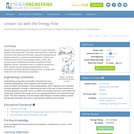
Students learn about energy and nutrient flow in various biosphere climates and environments. They learn about herbivores, carnivores, omnivores, food chains and food webs, seeing the interdependence between producers, consumers and decomposers. Students are introduced to the roles of the hydrologic (water), carbon, and nitrogen cycles in sustaining the worlds' ecosystems so living organisms survive. This lesson is part of a series of six lessons in which students use their growing understanding of various environments and the engineering design process, to design and create their own model biodome ecosystems.

The purpose of this resource is to observe plant green-down and report greendown data to help validate estimates of the end of the plant growing season. Students monitor the change in color of selected leaves of trees, shrubs or grasses.

The purpose of this resource is to observe plant green-up and report data that will be used by scientists to validate satellite estimates of the beginning of the plant growing season. Students monitor budburst and growth of leaves of selected trees, shrubs, or grasses. Species chosen should be native, deciduous, and dominant in your area.
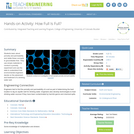
Students learn about porosity and permeability and relate these concepts to groundwater flow. They use simple materials to conduct a porosity experiment and use the data to understand how environmental engineers decide on the placement and treatment of a drinking water well.
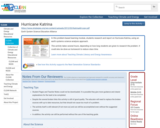
In this problem-based learning module, students research and report on Hurricane Katrina, using an earth systems science analysis approach.
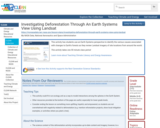
This activity has students use an Earth Systems perspective to identify the various causes associated with changes to Earth's forests as they review Landsat imagery of site locations from around the world.

This OSPI resource provides curated collections of free activities, lessons, units, and informational "texts" (articles, passages, e-books, videos, podcasts) to support every NGSS Performance Expectation (standard) in grades K-5. This resource is intended to support teachers with teaching science while also integrating science and ELA to grow student knowledge, thinking, application, and skills in both content areas. Materials are organized into units based on the topics and essential questions in each grade. Resources listed are all freely available online, with some requiring teachers to create free accounts to access. Some trade books are also listed that might be accessed through a library system. Gratitude is expressed to the Washington State Science Fellows, Science Fellows Emeriti, and ELA Fellows who contributed to curating the informational texts. For questions or comments contact OSPI Elementary Science at Kimberley.Astle@k12.wa.us.

The purpose of the resource is to determine the major land cover type at a Land Cover Sample Site.

The purpose of the resource is to produce a land cover type map from hard copies of Landsat satellite images.
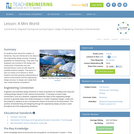
As students learn about the creation of biodomes, they are introduced to the steps of the engineering design process, including guidelines for brainstorming. Students learn how engineers are involved in the design and construction of biodomes and use brainstorming to come up with ideas for possible biodome designs. This lesson is part of a series of six lessons in which students use their growing understanding of various environments and the engineering design process, to design and create their own model biodome ecosystems.
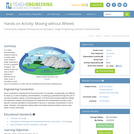
In a class demonstration, students observe a simple water cycle model to better understand its role in pollutant transport. This activity shows one way in which pollution is affected by the water cycle; it simulates a point source of pollution in a lake and the resulting environmental consequences.